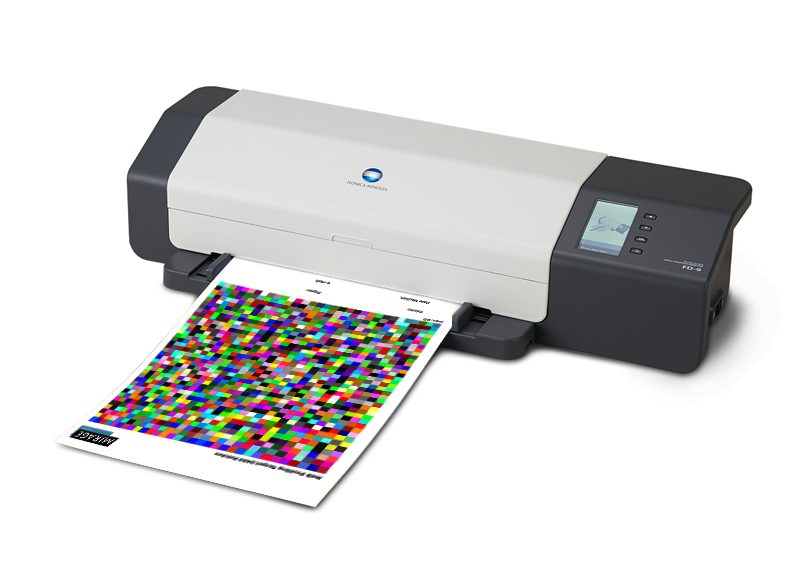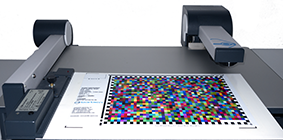Why do I need an ICC profile?
In simple terms, an ICC profile prevents color shifts and ensures that prints are vibrant and true to color. It also optimizes the reproduction of details in both light and dark areas.
This is achieved by fine-tuning various factors, such as adjusting the ink amount to match the substrate’s absorbency and setting a maximum ink limit to prevent paper bleed. The goal of a professional color management workflow is to fully utilize the color space of the inks, the specific printer, and the chosen substrate for optimal results.
ICC profiles are often included as part of software solutions. For example, Mirage comes with pre-installed ICC profiles for Epson and Canon printers. Additional media, along with their corresponding ICC profiles, can be downloaded as a bundled Mirage Media Package from our website. Furthermore, many media manufacturers offer generic ICC profiles free of charge on their own websites.

Modern printers from Epson or Canon offer very good print quality. However, the color reproduction of individual printers within a series of the same model can vary considerably. The ICC profiles supplied with Mirage or the printer driver are so-called generic profiles, which give very good results at first sight. Generic profiles are profiles that can be used for a certain printer series, for example for all Epson SureColor P5000 printers, but are not optimally adapted to your printer. Generic profiles, such as those found in software, media packages or on media manufacturers’ websites, can be used to achieve good results, but in most cases individual profiles offer a better print result.
An individual ICC profile ensures that your individual printer, the inks used, and the profiled media are optimally matched and optimized. This means you can achieve the best possible color matching even when using different media, for example when printing the same image on matt or glossy media.
When printing black-and-white images, for example, a slight color shift can be very disruptive. But even in landscape photography, a color shift can be very noticeable when areas are ‘washed out’ or when there are no visible lines in the light, even though your camera or scanner shows everything correctly on the monitor.
We want to be able to meet all requirements with individual ICC profiles. Depending on the substrate used, more measurement patches can give a much better result. Many papers are very ‘absorbent’ and can take up more ink than others. This absorptive behavior accounts for the fact that inks mix differently. For example, to produce the “reddest” red, magenta and yellow are theoretically mixed at 100% each. However, because the inks do not actually mix in the printing process, as if they were poured into a glass and stirred, it is possible that one of the two inks (yellow, for example) will penetrate deeper into the paper, requiring more yellow than magenta.
The higher your requirements for accurate color reproduction and neutral gray tones, the more patches should be used to create the ICC color profile. In our experience, at least 1000 patches are required to achieve optimal results, but more than 2000 patches is preferable. And because a higher number of patches means more work, these ICC profiles usually cost a little more. But it is worth it.
Once your order has been successfully placed, you will receive an email with a link to download the measurement file.
Unzip the downloaded file to your computer and open it with Mirage*. Mirage will warn you that the file does not contain color management.
Please make sure that no color management is applied or select “Do not modify”.
3) Select the printer, media and quality. If you are not sure which is the right media, please contact the paper manufacturer or your dealer.
4) Make sure that a warning appears above the print, telling you that no profile has been defined. This warning guarantees printing without colour management. Please do not change the file size. Any size other than the original size of the file will require the patches to be printed again.
5) To be able to name your profile, we need information about your base medium and printer. Please give us this information. Please do not write on the print. You can put a post-it on the back of the print file. If you have only ordered one profile, you can also attach a letter with the necessary information to the printed file. If you write anything in the reference areas of the printed file, we will not be able to read the measurement file.
6) When everything is ready, send the measurement file in a sealed envelope, not on a roll, to the following address
DINAX LAB Service
Fuggerstr. 9a
41468 Neuss
GERMANY
Please quote your order number and write the name of your profile and printer on the test chart.
Once we have measured the measurement file for you, we will send it to you by email with the invoice attached.
If you want to integrate the profile into Mirage, please follow these steps
1) Open Mirage and choose Settings…
2) Go to the User defined media tab
3) Select Add media …
4) Select the printer model and base media and name your media.
5) Click on Browse and navigate to the saved .icc file.
6) Confirm the settings with OK.
You will find your new media in the selection list in the Mirage print window.


-
ICC Profiling -Service and Workshops
Professional ICC-Profile for Dry-Labs
Ab / from 59,44 €incl. VAT
Select options This product has multiple variants. The options may be chosen on the product page -
ICC Profiling -Service and Workshops
Professional ICC-Profile with 1248 measurement patches
Ab / from 59,44 €incl. VAT
Select options This product has multiple variants. The options may be chosen on the product page -
ICC Profiling -Service and Workshops
Professional ICC-Profile with 2433 measurement patches
Ab / from 71,34 €incl. VAT
Select options This product has multiple variants. The options may be chosen on the product page


